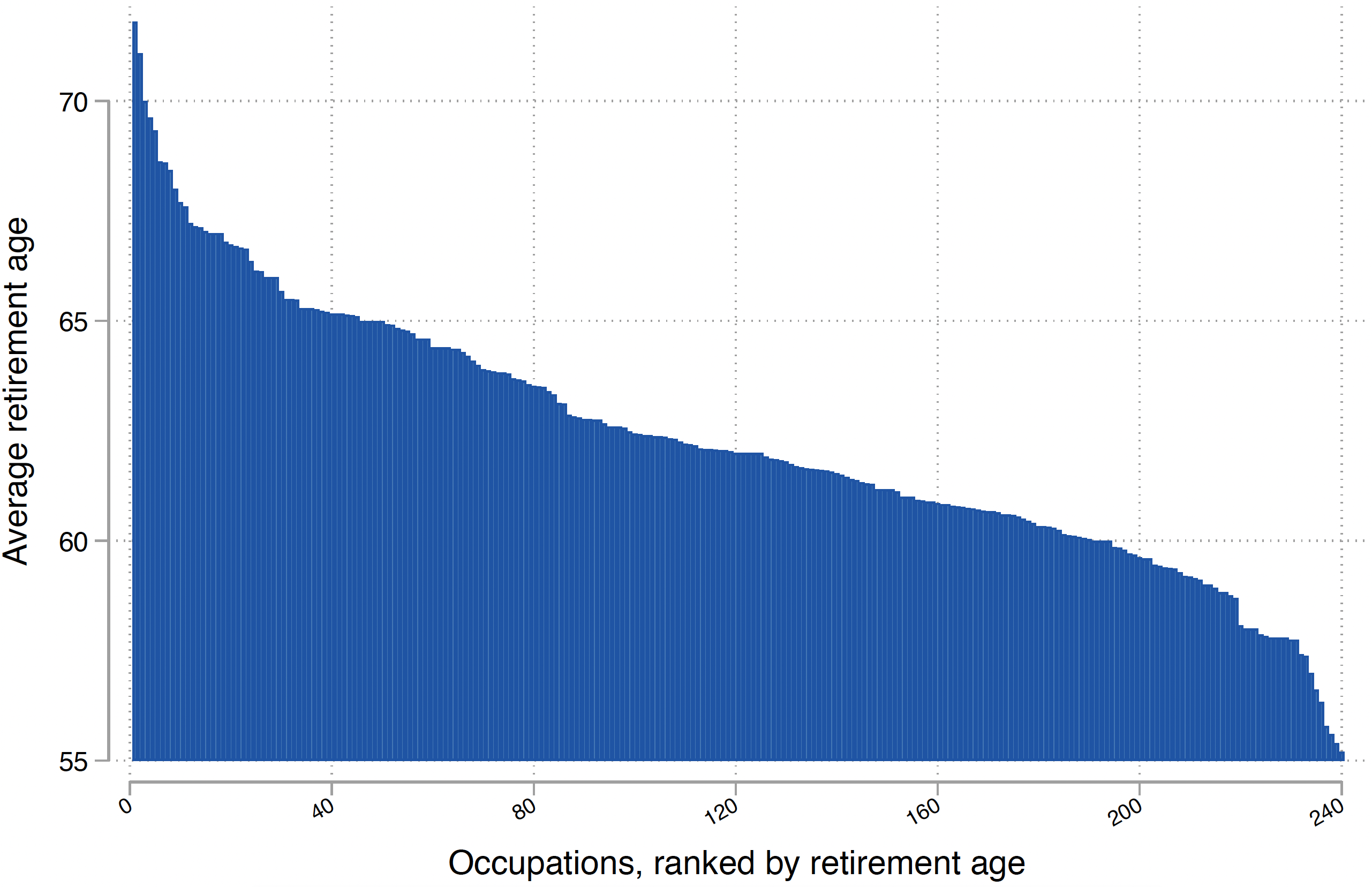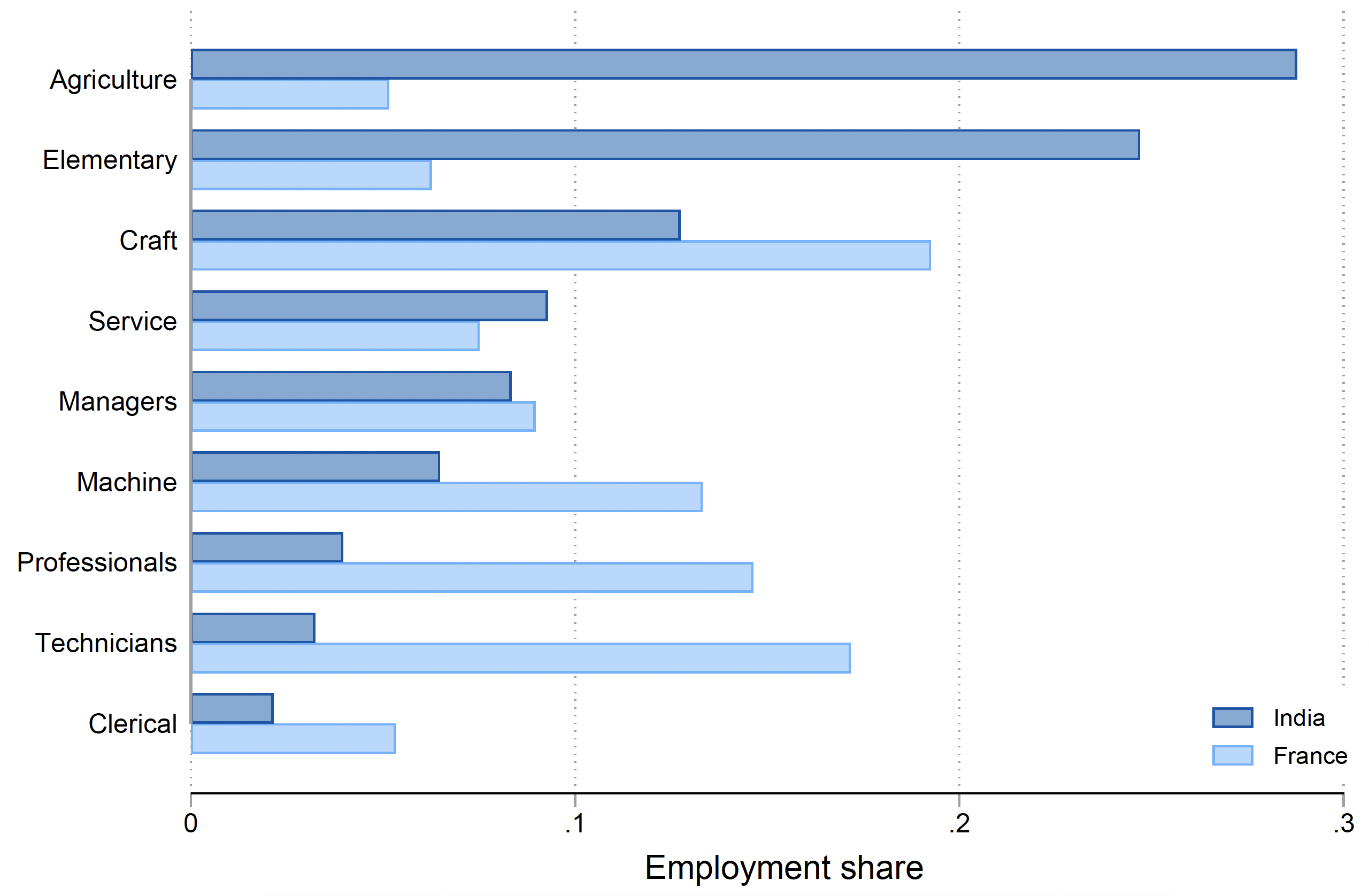Population ageing is widely seen as a central challenge for social security finances. Many countries are therefore implementing pension reforms to increase effective retirement ages. While such reforms can improve the fiscal balance of pension systems (Seibold 2021), a concern often voiced in public debates is that certain workers will not be able to postpone retirement and work until older ages. For instance, in the controversy around the recent French pension reform raising the early retirement age from 62 to 64, labour unions and protesters questioned the impact on workers in physically demanding occupations (New York Times 2023).
Our latest research sheds new light on the role of occupations in retirement behaviour. In a recent paper (Sauré et al. 2023), we show that occupation is a key predictor of retirement age at the individual level, and as a consequence, retirement behaviour across 45 countries is decisively shaped by the occupational composition of the workforce.
That occupations are an important determinant of retirement should not come as a surprise, given the ample interdisciplinary evidence of the association of occupations with health and labour market opportunities for the elderly. Large differences in physical and mental health across occupations are well documented by research in medicine and public health (e.g. Ettman et al. 2022, Garcia et al. 2023). Moreover, the speed of knowledge obsolescence and human capital depreciation varies across occupations (e.g. Aubert et al. 2006, Ahituv and Zeira 2011), and there are important differences in job flexibility and other ‘age-friendliness’ dimensions of occupations (Ameriks et al. 2020, Acemoglu et al. 2022).
Our analysis proceeds in three steps. First, we provide evidence of large occupational differences in individual retirement behaviour among US workers. Figure 1 plots the distribution of retirement ages by fine-grained occupations in data from the US Census Bureau’s Current Population Survey (CPS). Occupational retirement ages span a large range between 55 and 70 years. In our paper, we predict occupational retirement more formally and find that much of this dispersion can indeed be attributed to occupational differences rather than other worker characteristics.
Figure 1 Retirement ages across occupations
Notes: The figure shows the average retirement age of US workers by four-digit occupation codes. Occupations are ranked along the horizontal axis from highest to lowest retirement age.
In the second step, we show that predicted retirement ages of US workers are highly predictive of individual retirement behaviour in other countries. Using survey data on more than 13,000 elderly individuals from 18 European countries, we find a large positive correlation between individual retirement ages and US occupational retirement ages. Occupation-predicted retirement ages retain almost two-thirds of their explanatory power ‘out-of-sample’ in European data. This suggests that the underlying factors driving retirement across occupations are to a large extent universal.
In the third step, we document the aggregate consequences of these findings. Occupational composition accounts for a substantial portion of differences in retirement behaviour across countries. Figure 2 illustrates the cross-country variation in occupational composition for two countries, France and India. Notably, French workers are more likely to be in technical, professional, machine operator, and craft occupations, while Indian workers are more likely to be in elementary and agricultural occupations.
Figure 2 Occupational composition: France versus India
Notes: The figure shows the share of the labour force working in broad occupational categories (1-digit ISCO08 codes) for France and India.
Figure 3 shows that across 45 countries, actual retirement behaviour is highly correlated with the prediction based on occupational composition. Occupation-predicted retirement ages account for roughly one-third of the cross-country variation in effective retirement ages. This relationship has remained relatively stable over the last 20 years and is robust to including an extensive list of country-level characteristics, including GDP per capita and proxies for education, health, and labour market conditions.
Figure 3 Effective versus occupation-predicted retirement age across countries
Notes: The figure shows the correlation between effective retirement ages and predicted retirement ages based on occupations across countries. Labelled black dots denote country averages, and grey dots denote country-year observations. The red dashed line is a linear fit. The estimated slope coefficient b with its standard error in parentheses and the R2 of the regression are included in the figure.
Our results have implications for labour markets and social security systems. Regarding current policy debates around pension reforms, our findings suggest that workers in different occupations indeed vary in their ‘natural’ retirement age. Policymakers thus face the challenge of putting in place incentives to postpone retirement for individuals who are able to work longer, while offering some protection to those who are unable to do so.
More broadly, our results suggest that shifts in occupational composition are likely to have important side effects on social security systems. For instance, skill-biased technological change affects the returns to different types of occupations and ultimately alters the occupational distribution of the workforce (Autor 2019). As artificial intelligence use spreads, these occupational shifts are likely to accelerate over the coming decades. Our findings imply an easily overlooked side effect of occupational change on social security systems via changes in overall retirement behaviour.
References
Acemoglu, D, N S Muhlbach, and A J Scott (2022), “The rise of age-friendly jobs”, Journal of the Economics of Ageing 23: 100416.
Ahituv, A, and J Zeira (2011), “Technical progress and early retirement”, Economic Journal 121: 171–93.
Ameriks, J, J Briggs, A Caplin, M Lee, M D Shapiro, and C Tonetti (2020), “Older Americans would work longer if jobs were flexible”, American Economic Journal: Macroeconomics 12(1): 174–209.
Aubert, P, C Eve, and R Muriel (2006), “New technologies, organisation and age: Firm-level evidence”, Economic Journal 116(509): F73–F93.
Autor, D (2019), “Work of the past, work of the future”, AEA Papers and Proceedings 2019 109: 1–32.
Ettman, C K, G H Cohen, S M Abdalla, L Trinquart, B C Castrucci, R H Bork, M A Clark, I B Wilson, P M Vivier, and S Galea (2022), “Assets, stressors, and symptoms of persistent depression over the first year of the COVID-19 pandemic”, Science Advances 8(9): eabm9737.
Garcia, T C, A Ruano-Ravina, C Candal-Pedreira, R Lopez-Lopez, M Torres-Duran, J R Enjo-Barreiro, M Provencio, I Parente-Lamelas, I V Garcia, C Martinez et al. (2023), “Occupation as a risk factor of small cell lung cancer”, Scientific Reports 13(1): 4727.
New York Times (2023), “Why so many people in France are protesting over pensions”, New York Times, 13 April.
Sauré, P, A Seibold, E Smorodenkova, and H Zoabi (2023), “Occupations shape retirement across countries”, CEPR Discussion Paper 18161.
Seibold, A (2021), “Reference points for retirement behavior: Evidence from German pension discontinuities”, American Economic Review 111(4): 1126–65.
Zoabi, H, and P Sauré (2011), “Retirement age across countries: The role of occupations”, VoxEU.org, 19 November.








